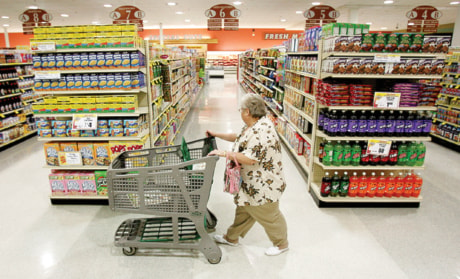TORONTO — Justin Bell and his fellow students at the University of Alberta believe groceries are eating up more of their bank accounts than before, even as the country’s biggest supermarkets insist they’ve had to slash prices to attract cash-strapped shoppers.
“I’ve heard people saying ‘I’m paying more for my groceries, I seem to be having to shell out more, the same stuff I used to buy for 50 bucks, now costs me 60 bucks a week,’” says the 27-year-old student.
Industry insiders say if grocery prices are falling, as Canada’s largest grocery chains report, it’s hard to tell because they don’t reveal how they calculate price fluctuation and the declines are likely limited to highly competitive areas and selected promotional products.
Furthermore, any price deflation will soon be erased by higher costs and improved demand.
Economists, industry organizations, academics and analysts say short-term food price deflation is based on chains competing for scarce shopping dollars and will rise into next year along with improved consumer sentiment and commodity prices.
John Cranfield, a professor of food economics and marketing at the University of Guelph, says no one wants to raise their prices because that will only encourage fickle customers to switch their loyalties.
However, he expects any price deflation reported by the big chains — Sobeys, Loblaws and Metro — will be erased over the next year and a half as even they can’t afford to absorb all of the rising costs.
And while experts say price hikes won’t be dramatic, Cranfield says the impact will be felt most by the most vulnerable Canadians—those who are already overextended or unemployed— because food costs eat into a larger portion of their income.
The rising prices of key crops like wheat and corn, which are found in an array of items on supermarket shelves, and other staples like coffee and sugar is going to further squeeze grocers’ margins.
Wheat prices are expected to spike into next year after Russia — the world’s third-largest wheat exporter— extended its export ban on wheat and feed grains until next November following a severe drought. Corn prices are also expected to rise due to an increase in demand for ethanol use.
Sobeys (TSX:EMP.A), Loblaws (TSX:L) and Metro (TSX:MRU), which together make up 60 per cent of the Canadian grocery market, maintain that ultra-competitive pricing is causing prices to fall and is taking a toll on their bottom lines.
However, Statistics Canada’s Consumer Price Index released last week shows the price of food bought at stores increased by 1.2 per cent compared with last August.
Sobeys president Bill McEwan said recently food prices have fallen by as much as 2.5 per cent in the recent quarter and holds his main competitors responsible for driving down prices in areas of southern Ontario where it has opened new discount Freshco stores.
“The deflation in this case is not driven by the economic factors of commodity prices or foreign exchange,” he said at a conference in Toronto last week.
“The deflation is what we call self-inflicted disinflation— it’s associated with competitive activity that’s taken place particularly in the Ontario marketplace.”
But John Scott of the Canadian Federation of Independent Grocers says the price deflation is largely contained in markets that can support multiple big name grocery stores, which advertise heavy discounts on specific products.
“There are spots where somebody has tried to get a little more market share by dropping prices on basic commodities,” Scott adds, noting that sales and promotional pricing has been more aggressive in the past year.
And, as Bell found out, extreme price fluctuations, even within one chain and one city, make calculating food prices even more complicated.
Bell, managing editor of his university newspaper, sent a team of volunteers, to compare grocery price around Edmonton on a list of core items, including apples, milk, cereal and coffee.
“One thing that surprised me is the same chain can have three different stores in town ... and all have different prices,” Bell said of the findings, which indicated the cost of the list at three Sobeys stores ranged from $58.08 to $80.39 and from $66.22 to $73.11 at two Safeway stores.
A major reason for the discrepancy between the official CPI figures and the figures released by the corporate world is that grocery chains are very secretive about how they calculate deflation, whereas Statistics Canada openly releases their methods — scanning an array of items and stores on a monthly basis.
Loblaws declined comment on the issue and several attempts to reach Sobeys and Metro were not returned.
Robert Cavallo, a retail analyst at Mackie Research Capital Corp., said the chains have been doing a good job at conveying the message that they’re being very tough on pricing in an extremely competitive market.
“There’s a good message being sent out to the consumer, but in reality, I don’t think pricing is ultra- competitive right now,” he says.
“If you look at Canada as a whole, it’s been very subdued competition ... I think right now all the grocers are in a position where I don’t think anyone really wants to compete yet on price.”
And despite what grocery retailers might say, “it’s a pretty good time to be a grocery operator,” he adds.
But Loblaw Cos. Ltd. president and deputy chairman Allan Leighton painted a bleak portrait of the climate for the Canadian grocery retailer — rife with downtrodden customers and downward pressures on their bottom line.
“There ain’t a lot of stuff that’s working particularly well that helps food retailers,” he told the retail- focused conference.
He cited continued concerns about the economy, projecting that levels of unemployment, household debt and personal bankruptcy — the three most important factors in supermarket sales — will persist, perhaps for years.
